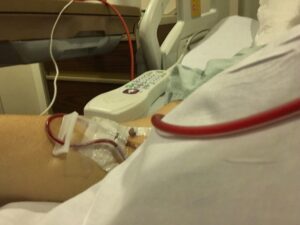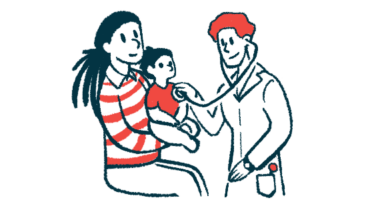How I overcome a fear of needles to receive CAD treatment and care
Checkups and infusions involve many needle sticks, which can be hard to endure

I was doing my best not to panic. I couldn’t get away even if I tried — there were too many assistant vampires surrounding me, and I couldn’t overpower them all. My breath came in short gasps, and I grew dizzy. Ouchie-wow-wow!
Oh, that hurt.
Over and over, the vicious head vampire stabbed my arm, trying to suck that life-giving fluid out of my veins. Perhaps it’d help if I held still and closed my eyes. Nope, the vampire was still there, unrelenting in the effort to get that huge needle into an elusive vein.
Cold agglutinin disease (CAD) is a rare blood disease. Because of this, every checkup requires a visit to the vampire for a blood draw. If my immunoglobulin M antibodies have increased in number, the doctor orders a round of treatments via infusions.
Needles and shots have been a terror for me since childhood. But finding a vein and puncturing my skin are part of the prescribed treatment for CAD. I can only try to project myself by visualizing a more peaceful place and breathing deeply. Therefore, I sit as still as possible and pray that my veins won’t collapse or roll.
My description may be hyperbolic, but many checkups and infusions do involve multiple sticks. After one morning when it took five tries and much bruising, which I later blamed on my husband and three nurses, I did a bit of sleuthing to learn if I could make things less painful.
Method over madness
The first method I use is to go to a more peaceful place in my imagination. For me, that’s either a beach or a forest scene. In my mind, I detail the sky, including the depth of the blue and the cumulus clouds floating across the heavens. The voice inside my head speaks slowly, in a low and calm tone. The description includes the scratchy texture of the sand beneath my bare feet.
After noting the visual depiction of the area, I try to remember any pertinent smells and sounds. By mentally removing myself from the bad situation of the blood stick, I’m reminding myself of a less violent time.
Accompanying the peaceful place, I incorporate slow, deliberate breathing. I breathe through my nose to a count of four, hold for another count of four, and then, with a disciplined exhale, release to a count of eight. I learned this technique in college, and it was reinforced during those unnecessary Lamaze classes before giving birth.
While this slow breathing helps, I also try to consciously relax specific muscle groups. First, I command my feet to tense and then relax. I move up to my calves, and then slowly tense and relax other muscles, especially my arm, which will get the stick. I do this while the nurse is getting the equipment ready.
I do two other things at home before arriving at the medical center. I warm my arms. I rest and relax them by massaging them with coconut oil and then wrapping them in warm, moist towels. The heat expands my blood vessels and muscles, and the oil softens my skin for the needle to slip through as effortlessly as possible. Smelling the coconut oil adds another relaxing sensation.
Finally, beginning two hours before my appointment, I try to drink a 10-ounce glass of water every half-hour. This ensures I’m fully hydrated and there’s plenty of fluid coursing through me to make my veins easier to find.
There’s a new invention used by some treatment centers called a vein finder. While I haven’t tried it yet, this hand-held device shows the nurse a map of a patient’s veins, making it easier to locate those hidden beneath the skin.
Do these methods work?
Blood draws are a necessary evil of CAD. I suppose evil is a bad choice of words. Perhaps inconvenience would be a more apt description. It removes the horror of the term and reduces the threatening stick to the momentary discomfort that it actually is.
I no longer regard the nurses as ghoulish vampires, and I look forward to a comprehensive blood count detailing what’s improved in my body and alerting me to possible deteriorating conditions. Only a blood analysis can provide that.
I’ve gone from being a person who was terrified of needles to someone who can sit still through the ordeal. I know I’m not the only one with this challenge. Many resources are available online for those who wish to search. These are the methods that work for me.
But I still can’t watch a stick. I turn my head and close my eyes.
Note: Cold Agglutinin Disease News is strictly a news and information website about the disease. It does not provide medical advice, diagnosis, or treatment. This content is not intended to be a substitute for professional medical advice, diagnosis, or treatment. Always seek the advice of your physician or other qualified health provider with any questions you may have regarding a medical condition. Never disregard professional medical advice or delay in seeking it because of something you have read on this website. The opinions expressed in this column are not those of Cold Agglutinin Disease News or its parent company, BioNews, and are intended to spark discussion about issues pertaining to cold agglutinin disease.









Comments